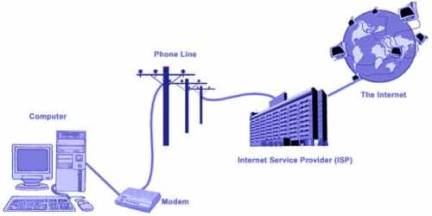Here one end of the telephone line is connected to the modem,
which can be an external or internal to your computer, and the
other end is inserted into the phone jack. You need to configure
the computer for dialup access and need to load the system with
appropriate driver for connecting to the modem. The modems are
usually belongs to the customer, and manufactured to comply
with international standards for modem protocols. At the other
end, the ISP will also have matching modem rack that contains
several such modems, one for each customer. Some times, several
modems are clubbed in to one physical hardware rack, and known
as modem rack.
Dial up Internet service is provided through several ISPs
and usually requires the permission from the government to operate.
The protocol that is used to connect a modem to its peer at
the other end (located at the local exchange) is called PPP
(Point to Point Protocol). There are different types of modems,
and most of them are inexpensive to purchase. You can have an
internal modem installed in a free slot of your computer, or
you can have an external modem that's hooked up to the computer
through cables. A telephone line is linked to the modem.
Any computer Operating System like Microsoft Windows has
Network Connection utility, which allows you to connect to the
Internet. In the Network Connection utility you have to set
up ISP profile so that the modem knows what phone number to
dial, and other connection parameters so that you can connect
to the Internet. When the modem dials the phone number your
ISP gives you, a connection is made, and then information is
transferred between the modem and the remote server. A remote
authentication server is the computer and related software that
is established to handle users who want to access a network
remotely. The username and password are required to access gateway
to the Internet. The gateway to the Internet is a network that
allows entry into the Internet.
The modems that are utilized in todays senario have maximum
speeds upto 56 kbits/s. With some multiplexing, it may be possible
to increase the speeds a little further, but not enough to meet
the existing demands. For example, contents such as 'streaming
media' may not be viable using traditional dialup access. Further,
services like video conferencing and online gaming, does not
work properly with a dial up internet connection.
b.Limitations of Dial Up Internet Access
- Slow access
- Limited bandwidth
- Cannot use phone and web at same time







